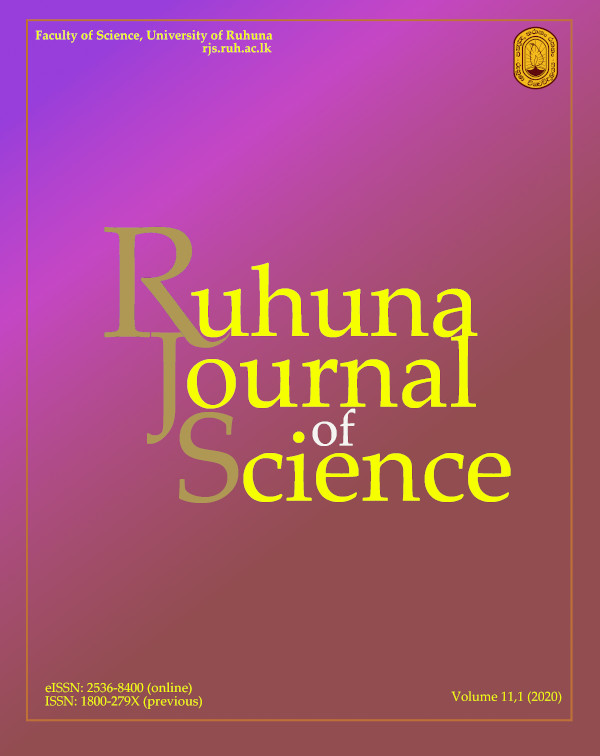Zagreb Topological indices for hexadentate 3-hydroxypyridinones-terminated dendrimers used in iron binding and anti-microbial activities
Abstract
Among the degree based topological indices which are mostly used in the study of chemical graph theory, the Zagreb index plays a prominent role in the study of therapies and treatments. There were different versions of the Zagreb indices defined in the literature and used for different purposes. In this paper, we calculated the different versions of the Zagreb indices for the hexadentate 3-hydroxypyridinones-terminated dendrimers which are used in iron binding and anti-microbial activities. These indices may play an important role in determining properties of these compounds. Keywords: Anti-microbial activities, dendrimers, iron binding, topological index, Zagreb index.References
Aslam A, Bashir Y, Ahmad S, Gao W. 2017. On Topological Indices of Certain Dendrimer Structures. Zeitschrift für Naturforschung 72: 559–566
Evstatiev R, Gasche C. 2012. Iron sensing and signalling. Gut 61: 933–952.
Farahani MR., Gao W, Kanna RMR. 2015. The connective eccentric index for an infinite family of dendrimers. Indian Journal of Fundamental and Applied Life Sciences 5 (S4): 766-771.
Gutman I. 2013. Degree-Based Topological Indices. Croatica Chemical Acta 86: 351-361.
Gutman I, Furtula B, Elphick C. 2014. Three New/Old Vertex–Degree–Based Topological Indices. MATCH- Communications in Mathematical and Computational Chemistry 72: 617-632.
Gutman I, Trinajstić N. 1972. Graph theory and molecular orbitals total f-electron energy of alternant hydrocarbons. Chemical Physics Letters 77: 535-538.
Haas JD, Browlie IV T. 2001. Iron deficiency and reduced work capacity: a critical review of the research to determine a causal relationship. Journal of Nutrition 131: 676S–690S.
Hao J. 2011. Theorems about Zagreb Indices and Modified Zagreb Indices. MATCH- Communications in Mathematical and Computational Chemistry 65: 659-670.
Jude TP, Panchadcharam E, Masilamani K. 2019. Computation of Zagreb and Randić indices of two biodegradable dendrimers used in cancer therapy. Ceylon Journal of Science 48: 359-366
Kang SM., Zahid MA., Virk AR., Nazeer W, Gao W. 2018. Calculating the Degree-based Topological. Indices of Dendrimers, Open Chemistry 61: 681-688.
Mahoney JR, Hallaway PE, Hedlund BE, Eaton JW. 1989. Acute iron poisoning – Rescue with macromolecular chelators. Journal of Clinical Investigation 84: 1362–1366.
Saliba AN, El Rassi F, Taher AT. 2016. Clinical monitoring and management of complications related to chelation therapy in patients with beta-thalassemia. Expert Rev Hematol. 9, 151–168.
Soleimani N, Mohseni E, Maleki N. 2016. Connectivity indices of some famous dendrimers. Journal of Chemical and Pharmaceutical Research. 8(8): 229-235.
Weizman H, Ardon O, Mester B, Libman J, Dwir O, Hadar Y, Chen Y, Shanzer A. 1996. Fluorescently-labeled ferrichrome analogs as probes for receptor-mediated, microbial iron uptake. Journal of the American Chemical Society 118: 12368–12375.
Wiener HJ. 1947. Structural Determination of Paraffin Boiling Points, J. Amer. Chem. Soc. 69: 17-20.
Zhang AS, Enns CA. 2008. Iron Homeostasis: Recently Identified Proteins Provide Insight into Novel Control Mechanisms. Journal of Biological Chemistry 284: 711–715.
Zhou T, Chen K, Kong L-M, Liu M-S, Ma Y-M, Xie Y-Y, Hider RC. 2018. Synthesis, iron binding and antimicrobial properties of hexadentate 3-hydroxypyridinones-terminated dendrimers. Bioorganic & Medicinal Chemistry Letters 28: 2504–2512.
Zhou T, Winkelmann G, Dai ZY, Hider RC. 2011. Design of clinically useful macromolecular iron chelators. Journal of Pharmacy and Pharmacology 63: 893–903.
Zhu J, Shi X. 2013. Dendrimer-based nanodevices for targeted drug delivery applications. Journal of Materials Chemistry B 134: 4199–4211.
Downloads
Published
Issue
Section
License
From Volume 7 (2016) onwards, all articles published in Ruhuna Journal of Science are Open Access articles published under the Creative Commons CC BY-NC 4.0 International License. This License permits use, distribution and reproduction in any medium, provided the original work is properly cited and is not used for commercial purposes.
Copyright on any research article published in RJS is retained by the respective author(s).
Authors who publish with this journal agree to the following terms:
a) Authors retain copyright and grant the journal right of first publication with the work simultaneously licensed under a Creative Commons Attribution License CC-BY-NC 4.0 International, that allows others to share the work with an acknowledgement of the work's authorship and initial publication in this journal.
b) Authors are able to enter into separate, additional contractual arrangements for the non-exclusive distribution of the journal's published version of the work (e.g., post it to an institutional repository or publish it in a book), with an acknowledgement of its initial publication in this journal.
c) Authors are permitted and encouraged to post their work online (e.g., in institutional repositories or on their website) prior to and during the submission process, as it can lead to productive exchanges, as well as earlier and greater citation of published work (See The Effect of Open Access).

